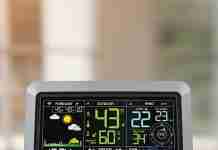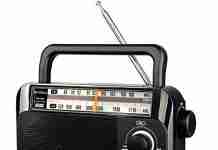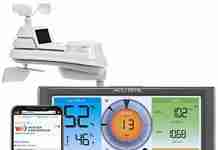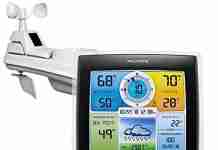In our quest for accurate weather data, we often overlook the importance of properly mounting external sensors for our home weather stations. Whether you’re an avid weather enthusiast or simply someone who wants to stay informed about the local climate, knowing the optimal locations for these sensors is crucial. In this article, we will explore the best places to mount external sensors for a home weather station, ensuring you receive the most precise and reliable weather information right from your own backyard. Say goodbye to unreliable readings and hello to a truly accurate depiction of your local weather conditions.
Review contents
Mounting Considerations
When installing a home weather station, there are several mounting considerations to keep in mind to ensure accurate and reliable data collection. These considerations include the height of the installation, the availability of shelter, and the accessibility of the sensors for maintenance. By carefully considering these factors, you can select the ideal location for mounting your weather station sensors.
Recommended Mounting Locations
To achieve the most accurate and representative weather data, it is essential to choose the right location for mounting your weather station sensors. Here are some recommended mounting locations that provide reliable data while ensuring ease of installation and maintenance.
Roof
Mounting the weather station sensors on the roof offers numerous advantages. Firstly, it provides an elevated position that minimizes obstructions and maximizes the line of sight for accurate readings. Additionally, it allows for better wind measurements, as the sensors can capture undisturbed airflow. However, when mounting on the roof, it is crucial to consider the optimal location, guidelines for installation, and avoiding potential obstructions.
Garden/Patio
Another suitable location for mounting your weather station sensors is in the garden or on a patio. Installing the sensors in this area ensures easy accessibility for maintenance while still providing accurate readings. However, you must consider clearance from vegetation, protection from rain, and ground stability to avoid any interference or damage to the sensors.
Fence
If your garden or outdoor space is enclosed by a fence, mounting the weather station sensors on it can be a viable option. This location allows for good visibility and accessibility while keeping the sensors at an appropriate height. However, it is important to consider potential interference from the fence material, height limitations, and ensuring a secure attachment for optimal performance.
Balcony
For those living in apartments or houses with balconies, mounting the weather station sensors on the balcony can be a convenient choice. However, there are a few factors to consider, such as the structural integrity of the balcony, exposure to the elements, and any privacy concerns that may arise from the installation.
Wall
Mounting the weather station sensors on a wall is another feasible option, especially if it offers a clear view of the surrounding area. When considering this location, factors such as visibility, installation height, and avoiding proximity to heat sources should be taken into account to ensure accurate data collection.
Pole
For areas with limited mounting options, mounting the weather station sensors on a pole can be a suitable alternative. This allows for a clear 360-degree view, minimizing obstructions and ensuring accurate readings. However, it is important to ensure a sturdy foundation and wind resistance to prevent any damage to the sensors.
Mounting on the Roof
Mounting weather station sensors on the roof offers an advantageous vantage point for accurate weather data collection. When choosing the optimal location on the roof, consider factors such as unobstructed line of sight, absence of shade, and sufficient distance from any potential sources of interference. Additionally, adhere to installation guidelines provided by the manufacturer to ensure proper mounting and alignment of the sensors. It is also essential to avoid potential obstructions, such as chimneys, satellite dishes, or nearby trees, to minimize sensor interference and obtain reliable measurements.
Mounting in the Garden/Patio
Mounting weather station sensors in the garden or on a patio provides accessible yet reliable data collection. To ensure accurate readings, it is crucial to maintain clearance from vegetation that may obstruct the sensors’ view or create false readings due to proximity. Additionally, providing adequate protection from rain or direct sunlight is necessary to prevent water damage or heat accumulation that may affect the sensors’ performance. Moreover, ensuring stable ground and a secure installation will prevent any disturbances or misalignments that could compromise data accuracy.
Mounting on the Fence
When mounting weather station sensors on a fence, it is important to consider potential interference that the fence material may cause. Avoid metallic or conductive fences that could distort readings or create electromagnetic interference. Additionally, take into account the height of the fence and ensure it allows for proper sensor positioning while adhering to recommended installation guidelines. Lastly, securely attach the sensors to the fence to prevent any movement or misalignment caused by strong winds or other external factors.
Mounting on the Balcony
Mounting weather station sensors on a balcony can provide a convenient location for apartments or houses with limited outdoor space. However, it is crucial to assess the structural integrity of the balcony before installation. Ensure that it can support the weight of the sensors and withstand potential wind loads. Furthermore, consider the exposure to elements, such as direct sunlight or excessive rain, as these factors can affect sensor performance. Finally, if privacy concerns arise from the installation, place the sensors in a discreet location on the balcony.
Mounting on the Wall
Mounting weather station sensors on a wall can be a viable option if it offers a clear view of the surrounding area. To achieve accurate data collection, position the sensors at an appropriate height for optimal wind and temperature readings. Additionally, avoid mounting them near any potential heat sources, such as vents or electrical panels, as this may affect temperature measurements. Ensuring the visibility of the sensors is also important to avoid any obstruction that could interfere with accurate data collection.
Mounting on a Pole
Mounting weather station sensors on a pole can be a suitable choice when other mounting options are limited. To ensure stable data collection, make sure the pole has a sturdy foundation that can withstand potential wind forces and prevent any swaying or vibrations. Moreover, mounting the sensors at an appropriate height on the pole ensures an unobstructed view, allowing for accurate data collection from all directions. Lastly, considering wind resistance when choosing the pole and mounting accessories will ensure the longevity and performance of the weather station.
Considerations for Multiple Sensors
In situations where multiple weather station sensors are being used, additional considerations come into play. It is important to maintain an adequate separation distance between the sensors to prevent signal interference or cross-contamination of data. Furthermore, ensuring proper sensor orientation, such as positioning anemometers in standard wind directions or angling rain gauges for optimal collection, is crucial for accurate measurements. By carefully planning the placement and orientation of multiple sensors, you can achieve comprehensive and reliable weather data from your home weather station.
Maintenance and Protection
To ensure the longevity and accuracy of your weather station sensors, regular maintenance and protection measures should be taken. Regularly clean the sensors to remove any debris or buildup that may affect readings. Additionally, protect the sensors from wildlife interference by using appropriate covers or deterrents. Finally, always prioritize health and safety by following the manufacturer’s guidelines for maintenance and taking necessary precautions when accessing or handling the sensors.
In conclusion, the best places to mount external sensors for a home weather station depend on various factors such as height, accessibility, and local environmental conditions. By considering these factors and following recommended guidelines, you can select an optimal location for your weather station sensors that will provide accurate and reliable data for all your weather monitoring needs.



































